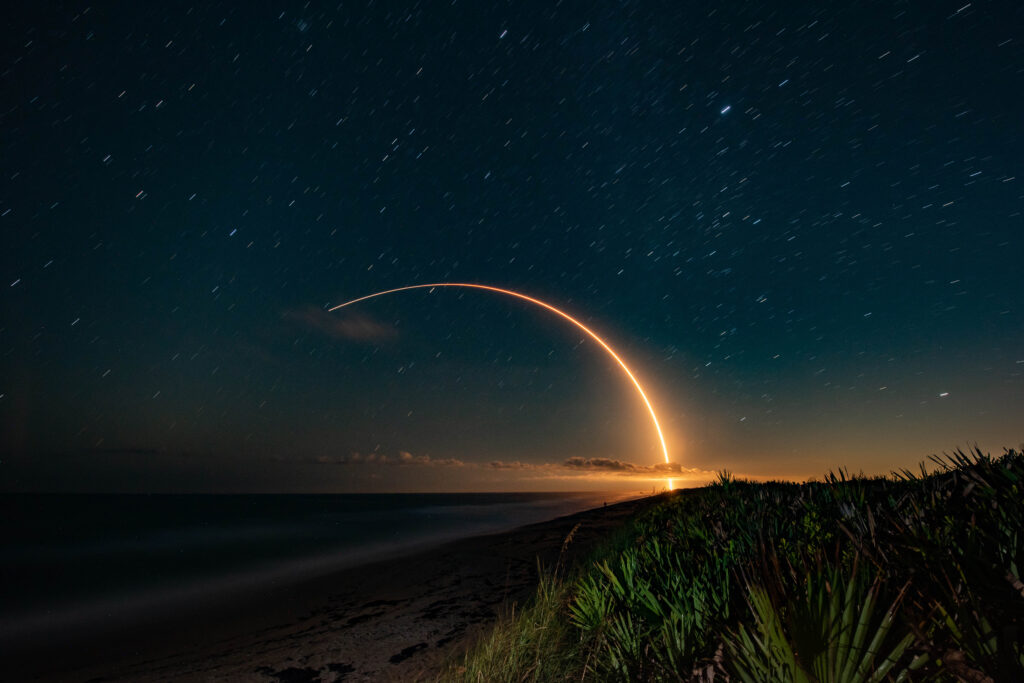
The night was dark and clear. The time: 5:10am—T-minus 20 minutes until the launch of a powerful Atlas V rocket. The place: Canaveral Seashore 24 miles north of Kennedy Space Center.
I placed our two tripods and cameras on the dune crossover and pointed them south. Framing the target was easy. The Palmetto covered sand dunes pointed directly to a soft glow of light beyond the horizon—Launch Pad for the Atlas 5 rocket carrying the LUCY mission to the asteroids of planet Jupiter.
We could hear the loud crashing of ocean waves, but could not see them. On this remote Florida barrier island, we were far from artificial light. The stars blazed vividly from the Mosquito Lagoon to the west to the dark Atlantic Ocean horizon to the east. We were
out in the wild, the largest undeveloped beach on Florida’s Atlantic Coast—where the night belongs to swaying Sea Oats, Sea Grapes, foraging Racoons, Wild Boars and nesting
giant Sea Turtles.
Using the live view screen on the camera backs, I focused until the stars appeared pin-sharp.

giant Sea Turtles.
(The trick to this technique is to pre-set your focus to Infinity back in the car. Wearing a head lamp to avoid fumbling in the dark is essential. Dial the ISO to the max to around 10,000 to easily locate a bright star on the live view screen, zoom in all the way, then focus until the stars cease to be round balls and shrink down to become points of light)
At T-minus 10 minutes, both cameras were focused. My wife and I framed the Cape’s glow in the bottom right hand third of the frame. I hoped the rocket would head east over the ocean—and not south and away from us.
“Camera One” was a Nikon D810 and 17mm to 24mm wide -angle lens for the “Rocket Trail Arc Shot”. I love long exposure night photography—the camera resolves details the human eye could never see.
With the shutter on the bulb setting, I would press a remote trigger once to start and once to stop the exposure. I took a 4 minute test shot of the stars and decided on ISO400 and F11. I imagined the rocket taking about 4 or 5 minutes before it would vanish from view based upon earlier launches I had photographed from my home 120 miles south in coastal Jupiter Florida.
“How do you know the settings are right”, my wife asked. “I don’t, I replied.” With my limited math skills, this process a combination of trial and error and best guess.”
“We’ll just come back again, next rocket, “she agreed. “Exactly. “Real adventure doesn’t come with a fool proof instruction book.” My “stars only test shot “showed me I had enough light coming into the lens to see some bright stars. I had never been this close before, and feared “blowing out” the extreme highlights” of the the blazing trail. I was shooting in RAW, so Lightroom’s “Dehaze Slider” would save my shot, if I overexposed too much.
“Camera Two”, a Nikon Z7II was our back up. I tested 20 second exposures until the stars looked good at F8 and ISO 500. I put the shutter on a 2-second delay, and asked my wife to
press the shutter after each exposure appeared on the back screen of the camera. We could always adjust in mid-flight. I hoped for a great take-off shot, and a great second stage “halo”.
At T-minus 2 minutes, we were ready to go and the excitement was building.
We waited. We waited. And then, the glow of the Cape, expanded like a super nova. Imagine watching a distant flare of light bright enough to illuminate most of the sky.
The Atlas V slowly rose above the Palmetto covered dune and the rolling Atlantic surf
It climbed silently and was momentarily eclipsed by a cloud.
Rays of light beamed in all directions from behind the cloud before
Ithe full rocket emerged brighter than before.
Suddenly, the air and ground shook buffeting our nerve endings.
We spontaneously cheered. Even at 24 miles distance, the sound of the immensely powerful rocket engines drowned out the ocean waves.
The back of Camera Two lit up every 20 seconds with a new image—each a short bright trail of fire wonderfully reflected across the ocean and the wet sands of the beach.
For five spellbinding minutes, we admired the beautiful curve of light draw itself across the sky.
When it dimmed, I closed the shutter of camera one and was rewarded with the money shot we wanted. A modern rocket light trail lancing over a wild and raw coast line. I had a shot with no bridges, piers,nor people!
For me, the key to getting a keeper shot required viewing in advance, many web published images and videos. I’ll save you a lot of time. Go right to the site of rocket and night photography expert, Ben Cooper http://www.launchphotography.com His work is in a league by itself. I also recommend practicing days before–setting up your camera in a dark room with only a headlamp. Without this practice, I would have missed this great opportunity for a picture to be proud of.

You can learn more about launches at the following sites: https://spaceflightnow.com
http://www.ulalaunch.com https://www.spacex.com/launches/
